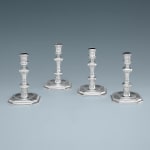

Paul de Lamerie
A Set of Four Queen Anne Antique English Silver Candlesticks, 1713
Height: 6 1/2"
Weight: 47 oz. 6 dwt.
Weight: 47 oz. 6 dwt.
London
H0711
$ 85,000.00
These are one of only two surviving sets of four Lamerie candlesticks from the Queen Anne period. Their generous proportions and simplicity of design show how even at this early...
These are one of only two surviving sets of four Lamerie candlesticks from the Queen Anne period. Their generous proportions and simplicity of design show how even at this early date Lamerie was subtly modifying existing designs to create something different--an ability which would lead three years later to his being named Royal Goldsmith by George I, and retaining that title until his death thirty five years later.
The arms are probably those of Chenevix. According to the Huguenot Museum (https://huguenotmuseum.org/about/news/huguenot_names/chenevix/):
"The Chenevix family, from Picardy, arrived in England around 1682. Philip Chenevix became a Major with the 2nd Carabineers where he fought in the famous battle of Blenheim (1704). Philip died in the battle but his son Paul Daniel Chenevix continued the family name.
The first records we have of Paul is of his shop in Suffolk Street, London 1731. From this shop, at the Sign of the Golden Door, we know he sold a pair of silver buckles.
In 1729 his premises moved to Pall Mall where Paul continued to sell high end goods – selling Earl Fitzwalter ‘a long gold head for a cane’ at the cost of £6, 11s.
After Paul’s death (1740s) his wife continued to run the shop and remarried Peter Russel, a ‘toyman’. Together they ran the shop selling expensive trinkets and it became known as the ‘toyshop’, Mrs Chenevix earning herself the reputation of ‘toy-woman à la mode’."
Many of the officers at the battle of Blenheim went on to become significant patrons of Paul de Lamerie: among them of course Marlborough himself, Major General Sir William Tatton, and the descendants, at least, of Daniel Chenevix.
The arms are probably those of Chenevix. According to the Huguenot Museum (https://huguenotmuseum.org/about/news/huguenot_names/chenevix/):
"The Chenevix family, from Picardy, arrived in England around 1682. Philip Chenevix became a Major with the 2nd Carabineers where he fought in the famous battle of Blenheim (1704). Philip died in the battle but his son Paul Daniel Chenevix continued the family name.
The first records we have of Paul is of his shop in Suffolk Street, London 1731. From this shop, at the Sign of the Golden Door, we know he sold a pair of silver buckles.
In 1729 his premises moved to Pall Mall where Paul continued to sell high end goods – selling Earl Fitzwalter ‘a long gold head for a cane’ at the cost of £6, 11s.
After Paul’s death (1740s) his wife continued to run the shop and remarried Peter Russel, a ‘toyman’. Together they ran the shop selling expensive trinkets and it became known as the ‘toyshop’, Mrs Chenevix earning herself the reputation of ‘toy-woman à la mode’."
Many of the officers at the battle of Blenheim went on to become significant patrons of Paul de Lamerie: among them of course Marlborough himself, Major General Sir William Tatton, and the descendants, at least, of Daniel Chenevix.

